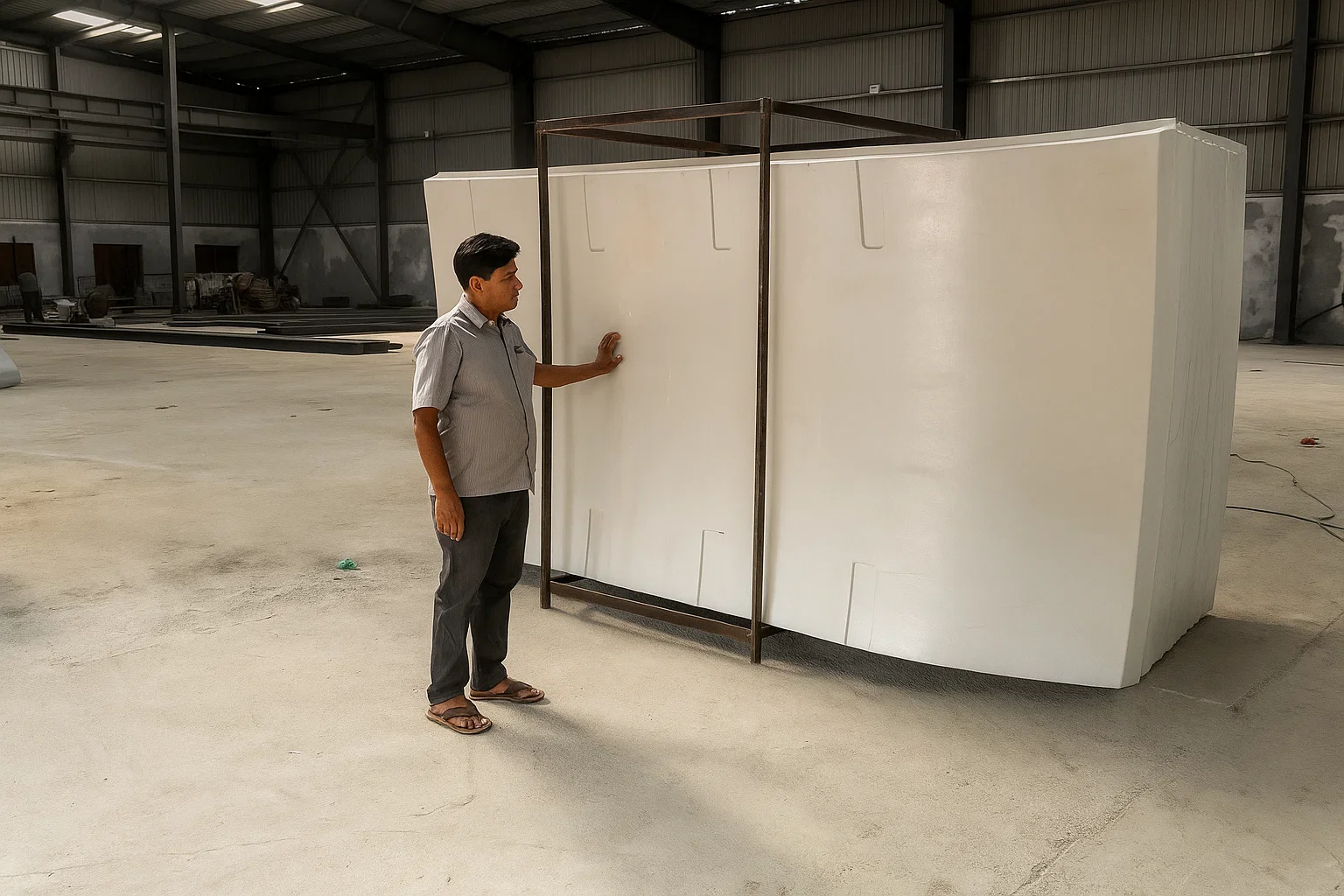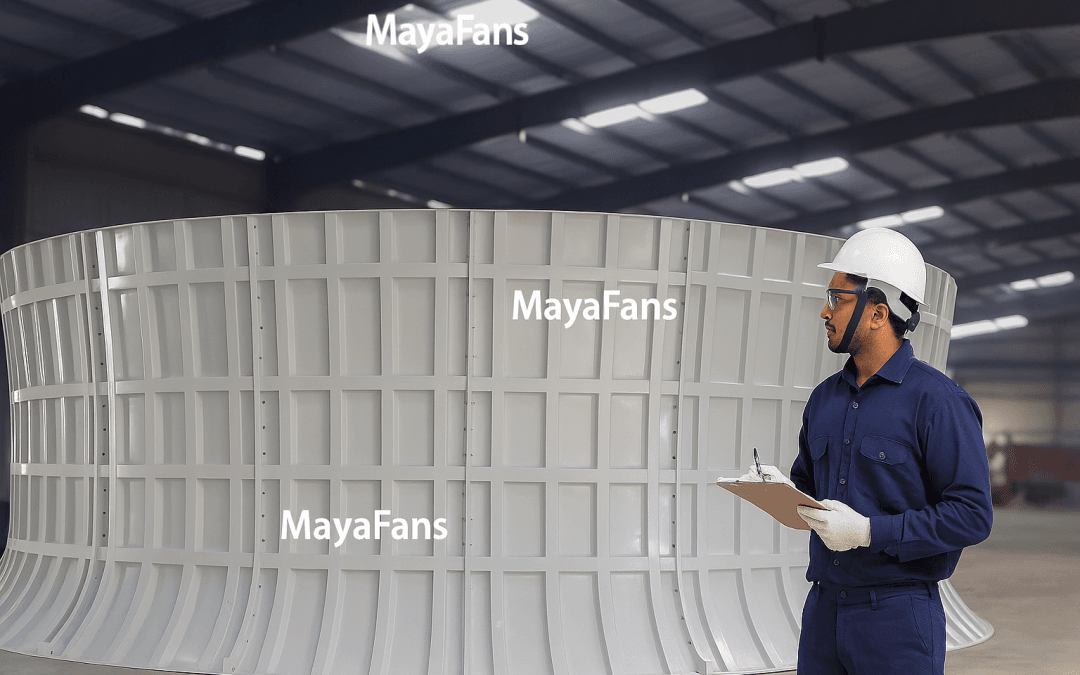
Understanding the Role of the FRP Fan Stack
A fan stack is the structure that surrounds the axial fan in a cooling tower or air-cooled condenser. It typically comprises a combination of up to three sections: a mandatory cylindrical portion, and two optional components—an air inlet bell and a venturi (or recovery) cone. The fan stack may consist of only the cylindrical section, a combination of any two, or all three, depending on design requirements.Constructed from Fiber Reinforced Plastic (FRP), the fan stack performs several critical aerodynamic and protective functions:- Directs airflow to minimize turbulence and recirculation.
- Recovers velocity by converting kinetic energy into static pressure.
- Reduces fan noise through smoother airflow transitions.
- Protects the fan system from UV radiation, weather, and corrosion.
The Myth of 100% Velocity Recovery
One of the most common missteps in fan system design is assuming perfect velocity recovery. Engineers often model systems under the assumption that the fan stack will recover all kinetic energy from the high-velocity air expelled by the fan, converting it into usable static pressure.But in reality, this is rarely achieved—and surface roughness is often to blame.Why Surface Finish Matters:
- A rough interior creates air friction and turbulence, leading to drag.
- Turbulence disrupts smooth laminar airflow, reducing velocity recovery by up to 15 –30%.
- This gap between design and real-world performance results in increased fan power consumption, reduced efficiency, and in some cases, regular wear and tear.
The Three Key Types of Surface Finishes
Surface finishes typically fall into one of three categories, each offering distinct advantages depending on operational priorities and environmental conditions:1. Inside Finish – Optimizing for Airflow Efficiency

An inside-finish fan stack features a highly polished, mirror-smooth interior surface. The smoother the internal flow path, the less resistance air faces as it passes through and exits the stack.
Benefits:
- Enhances velocity recovery by up to 35%.
- Lowers fan power requirements.
- Reduces operational noise.
- Improves laminar flow, especially valuable in high-static-pressure systems.
At Maya Fan Air Engineering, even our inside-finish stacks are provided with an additional UV-protective exterior as a default upgrade, ensuring they remain resilient to environmental exposure without compromising the aerodynamic interior.
Ideal for:
- Cooling towers Fan Stack and Air-Cooled Condenser Fan Ring
- Systems prioritizing energy savings and quiet operation.
2. Outside Finish – Shielding Against Environmental Damage
This finish focuses on the external durability of the fan stack, with coatings or gel coats that resist UV radiation, acidic gases, salt-laden air, and thermal fluctuations.
Benefits:
- Protects against material degradation, delamination, and structural fatigue.
- Extends the lifespan of the stack, especially in chemically aggressive outdoor environments.
- Retains dimensional stability despite harsh exposure.
The interior surface in outside-finish stacks is typically left untreated or minimally polished, which may result in slight airflow inefficiencies.
Though at Maya Fan we provide a Top Coat layer which manage to provide a smooth and slippery surface to guide the air smoothly toward the exit for the fan stack.
Trade-offs:
- Reduced velocity recovery, potentially by 15–30%, due to unoptimized airflow.
- Slight increase in fan energy consumption over time.
Ideal for:
- Cooling towers in coastal regions, chemical processing plants, or mining operations.
- Applications where structural integrity trumps efficiency gains.
3. Both-Side Finish – The Premium, Performance-First Solution
A both-side finish combines the aerodynamic interior of the inside finish with the weather-hardened exterior of the outside finish. This is the ultimate configuration for mission-critical operations where system failure or inefficiency is not an option.
Benefits:
- Delivers maximum velocity recovery, approaching theoretical 100% recovery values.
- Maintains durability in the most aggressive environments.
- Reduces noise, power draw, and maintenance needs.
Trade-offs:
- Higher manufacturing cost due to additional processing steps and criticality of the manufacturing process.
- Longer production timelines due to the dual-finish application and curing process.
Ideal for:
- Power generation plants.
- Petrochemical complexes.
- Infrastructure with tight uptime and performance KPIs.
The Science: How Surface Finish Shapes Velocity Recovery
To understand the physics behind these benefits, consider Bernoulli’s principle applied to axial fans: as air exits the fan at high velocity, its kinetic energy can be partially converted to static pressure if the flow is decelerated smoothly. And if the surface finish is not good in this transition, then it wastes the opportunity to reclaim energy.
A conical or bell-mouth shaped air inlet also helps smooth entry of air in the fan stack, but surface smoothness ensures minimal energy loss during air entry. The rougher the surface, the more air becomes turbulent.
In practical terms:
- A 10% drop in velocity recovery from turbulence could result in a 6–8% increase in fan motor load.
- Over the life of the equipment, this results in significant energy costs, especially in continuous-duty industrial environments.
Computational Fluid Dynamics (CFD) simulations—such as those employed at Maya Fan—demonstrate this relationship clearly, showing how minor imperfections in surface smoothness create turbulence zones that amplify inefficiencies.
Selecting the Right Finish: A Strategic Framework
Choosing a surface finish isn’t just a materials decision—it’s a strategic engineering call. Here’s how to align finish types with your system’s demands:
| Priority | Recommended Finish |
| Maximize energy efficiency | Inside Finish or Both-Side Finish |
| Handle harsh environmental conditions | Outside Finish or Both-Side Finish |
| Balance performance and longevity | Both-Side Finish |
| Budget-sensitive upgrades | Inside Finish with UV-protection |
| Mission-critical uptime | Both-Side Finish (premium) |
Also consider:
- System design: High-velocity fans benefit more from conical stacks with smooth interiors.
- Maintenance cycles: Ease of cleaning is enhanced with smoother surfaces.
- Installation environment: Corrosive gases or particulate matter may demand reinforced finishes.
Beyond Finish: Additional Factors That Matter
Surface finish, though vital, is just one part of optimal fan stack design. Others include:
- Stack Geometry: Conical vs cylindrical profiles affect pressure recovery and recirculation patterns.
- Material Quality: High-grade FRP with tightly controlled resin ratios enhances structural integrity.
- Joint Sealing and Mounting: Poor installation can negate surface finish advantages.
- Inspection & Maintenance: Even polished interiors degrade with dust, algae, or scaling buildup—periodic cleaning is essential.
Final Thoughts: Engineering for Real-World Performance
In the pursuit of cooling tower efficiency, assumptions are the enemy of reliability. Assuming 100% velocity recovery without validating surface conditions leads to overestimated performance and underestimated energy costs.
Surface finish, though rarely discussed outside technical circles, remains a high-leverage design parameter. A modest investment in finishing quality often yields disproportionately large returns in efficiency, durability, and operational savings.


Recent Comments